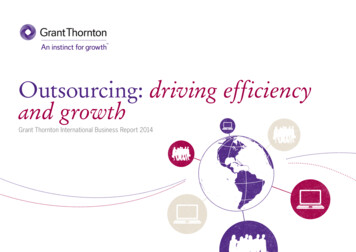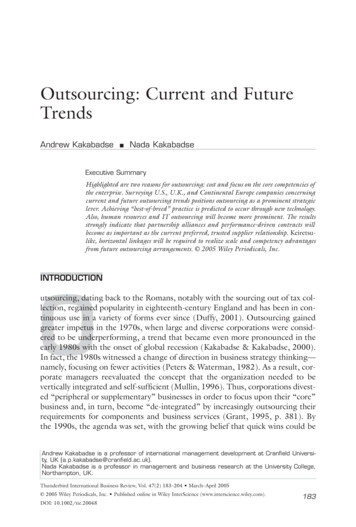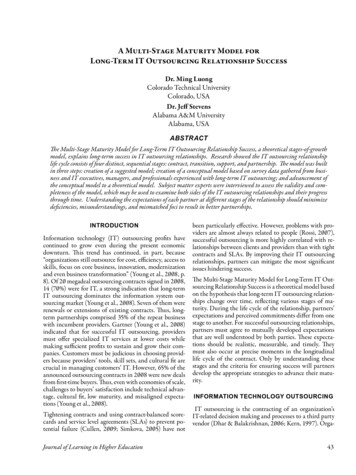
Transcription
The SharedServices RoadmapCut costs and increase standardizationwith these best practices
Introduction:Why Shared Services?A shared services model allows companies to streamline theiroperations across an organization and provide centralized,standardized support to all business units. From finance to legalto IT, companies can achieve great benefits from consolidationand implementation of strong governance systems.High decentralization and redundancies of operations withinan organization can cause problems and inefficiencies, andmost large companies can benefit from a more consolidatedapproach to business support. However, creating a sharedservices strategy can be challenging. To effectively consolidateservices, companies need to employ best practices in developingstrategic roadmaps and implementing them. And it is importantto validate that the strategy will actually provide business valueand not introduce additional problems, which requires a thoroughunderstanding of the organization’s needs and the systems andprocesses necessary to implement them.There is no one-size-fits-all approach to shared services.By investing the necessary time and effort in developing aneffective fact-based analysis and plan, companies can avoidproblems and ensure their transformation delivers the greatestpossible business value.This guide will go over some of the benefits of a sharedservices approach, as well as best practices for how to executea successful shared services center that reduces costs andincreases standardization.2thinkwgroup.comThe Shared Services Roadmap i COPYRIGHT 2017 WGroup
Is a Shared ServicesCenter for You?A shared services center (SSC) is an internalorganization that offers services to businessunits within the company. Much like anexternal business, it will often offer its serviceswith contractual agreements that enumeratethe cost, timeline, and quality metrics of theservice. This allows companies to combinethe advantages of outsourcing with theadvantages of completing projects in-house,allowing them to focus on core business issueswhile reducing costs.One of the greatest challenges associatedwith decentralized and dispersed services islow standardization across an enterprise. Thiscan cause a number of problems, includingcompliance issues and technical incompatibility.Managing one shared services “business” allowscompanies to implement standardized changesmore rapidly and effectively, while maintaininga high degree of control.
Is a SharedServicesCenterfor You?Consider these five common problems that arise without anSSC model:1.Compliance difficultiesThe most obvious problem with low standardization iscompliance. Large enterprises that must adhere to strictregulations often struggle to ensure that all business units areperforming their duties according to internal or external rules.By rolling these services into one SSC, company leaders canbetter oversee these processes, reducing risk.2.Difficulty measuring performanceWithout consolidation, it becomes extremely difficult to measuresuccess across the company. When services are undocumented,implemented using different methods, and not organized intoa central unit, it is almost impossible to collect meaningfulstatistics that allow leaders to evaluate performance and makeimprovements. An SSC eliminates these problems and offersa significantly more transparent way of delivering services tobusiness units.3.Lack of accountabilityIn a shared services model, it is always clear where theproblem lies when there is a mistake. Under more traditional,decentralized models, this is not always the case. When thereis no formal SSC, no one is fully responsible, which creates alack of incentive to perform duties effectively.4thinkwgroup.comThe Shared Services Roadmap i COPYRIGHT 2017 WGroup
Is a SharedServicesCenterfor You?4.Poor process documentationWithout a shared services model, companies don’t provideclear guidance on what employees should be doing and when.Workers often end up doing a range of tasks not in their jobdescription, taking them away from their core goals. Tasks also arenot well documented, often leading to confusion about howobjectives should be accomplished, and further feeding the lackof standardization across the organization.5.High costsSupporting dozens of dispersed back-office, service-delivery effortsis simply costlier and less efficient than supporting a single SSC.With shared services, companies can deliver better service, havemore control over their support units, and allow business units tofocus on their core goals—ultimately driving higher profits andreducing inefficiency within the company.
The Four Phasesof a SuccessfulSSC ImplementationGiven the significant benefits of shared services,it may seem surprising that many companieshaven’t fully embraced the strategy. One ofthe primary reasons for this is the difficulty ofimplementation. Without careful planning andthe right guidance, many enterprises will beunable to develop a strategy that allows themto transition while minimizing risk and maximizingefficiency at the same time. Creating aneffective shared services strategy requiresa deep understanding of company needsand capabilities, as well as the realities of themarket.
Phase One:Strategizeand AssessImplementing aneffective SSCstarts with a solidfoundation. Thismeans workingwith end users andleaders acrossthe company todetermine currentservice-maturitylevels, needs, andgoals for the future.Build a structured teamNo successful transition will occur without a well-defined teammade up of key stakeholders and technical experts from acrossthe company. The team should be structured, with a projectmanager and clear delegation of duties. It also is important toensure that company leadership is fully on board with theteam’s goals and is available to provide guidance.Assess maturity levels and needsThe first step of creating an effective shared services strategy isto do a period of initial assessment to get a better idea of thecompany’s state of affairs. Processes must have the right levelof internal control, because with centralized services, smallmistakes will be magnified. If your company already has sharedservices, it is important to look at ways that the services could beimproved and further consolidated. Areas to assess include: The Shared Services Roadmap i COPYRIGHT 2017 WGroupCurrent technologyCurrent implementations of shared servicesImpact on people and managementImpact on risk levelsImpact on business processesImpact on costthinkwgroup.com7
Phase One:Strategizeand AssessDevelop a high-level strategyOnce needs have been assessed, begin drafting an executivebriefing that articulates how success looks, without going intogreat detail. Outline what shared services can do for thecompany and what high-level steps need to be taken to getthere. This should include a business strategy supported bybaseline data, along with a conceptual description of deliverydesign and strategy. This accomplishes two things. First, it helpsthe company better formulate its ideas, forming a foundationfor more concrete planning. Second, it serves as an elevatorpitch to help build consensus for the transition across theorganization.Define the business caseA business case is critical to gaining the support of business leadersand ensuring the success of the initiative. It will help to outline theproblems with the existing model and articulate the productivityimprovements that shared services can bring.A shared services strategy is only as strong as the foundation uponwhich it is built. Start by creating your team, performing thoroughneeds assessments, and making sure you have buy-in from your keystakeholders.
Phase Two:Designand BuildAfter high-level strategic planning has beenaccomplished and a consensus about the generalstrategy to pursue has been reached, it is importantto begin developing more detailed plans for designand implementation. This means an articulation ofwhat steps are necessary to get from the currentstate to a developed state—including a strategyto integrate the technology required to implementan SSC; determining which locations will beresponsible for what services; allocating resources;and deciding how to deal with impacts onemployees.Develop a location strategyUltimately, services must be delivered from a physical location.If existing services are dispersed across multiple sites, companiesshould evaluate each site for personnel and technicalinfrastructure. It may be necessary to choose multiple locationsfrom which to deliver services, if the enterprise is very large orspread across several regions.The Shared Services Roadmap i COPYRIGHT 2017 WGroupthinkwgroup.com9
Decide on a human resources (HR) strategyPhase Two:Designand BuildA shared services HR strategy must include decisions about who’sgoing to work in the SSC, who needs to be outsourced, and whocan be managed internally. Certain shared services jobs couldbe thought of as an opportunity to nurture young talent. Thesepositions can develop and grow a certain skill set, such as linemanagement.This allows employees to gain a more detailed understandingof their roles and re-enter the main business units with moreknowledge and skills. Bringing in consultants at this stage canadd additional insights into new methodologies that challengethe status quo in the organization.It is important to remember that not all jobs will be preserved in aneffective SSC. Redundancies and inefficiencies must be eliminatedto guarantee success. This is why developing an early HR strategy iscritical, as well as clear documentation of what HR needs to do tofacilitate the transition.Create a technology roadmapTechnology is a critical component of implementing an SSC.Effective IT solutions can help the SSC deliver support to businessunits more effectively, and improve efficiency in an unstandardizedorganization. The transition team must work to define whattechnologies are required, what data needs to be consolidatedand centralized, and what testing and performance metrics shouldbe implemented to increase effectiveness. This section of the planis useful as a supporting document for IT funding requests.Do a risk assessmentAlthough shared services may actually help reduce risk in theorganization overall, they may also present new risks the companymust address. That’s why it is important to perform a detailed riskassessment and create a management strategy. During this stage,it is critical that team leaders identify relevant risks that thetransition might affect. These might include (though are notlimited to) the loss of data or a reduction in service availabilityand reliability. Processes should be implemented to help controlthese risks during and after the transition.10thinkwgroup.comThe Shared Services Roadmap i COPYRIGHT 2017 WGroup
Determine an operation-cost strategyPhase Two:Designand BuildThe transition team must determine how costs will be accountedfor and incorporated within the organization. Many enterprises runtheir SSCs as businesses, which charge business units for the servicesthey provide. This allows costs to be spread across the businessunits proportionally to how much they use the service. It also ispossible to make the SSC a centralized cost center with its ownindependent budget.Establish good governance mechanismsGood governance is one of the most important componentsof any shared services strategy. Companies must have a clearunderstanding of how shared services units will communicatewith internal customers (business units and corporate), and howthey will communicate with external customers. This will helpensure that roles are always clear and that strategies and goalsare well-aligned across the enterprise.WGroup recommends a three-tier governance model:1. Day-to-day: requires weekly or monthly review of everydayoperational items—essentially smaller, non-strategic concernsthat can be discussed and allow the enterprise some granularcontrol over the SSC.2. Strategic: requires business leaders to determine what newtools and technologies are needed to improve service offerings,as well as deal with new operational risks and other strategicconcerns.3. Executive: requires companies to consider new innovationsand forward-thinking strategies that could help drive futureefficiencies. Business executives should strive to leverageexisting processes as much as possible and integrate theminto the overall corporate business strategy.The Shared Services Roadmap i COPYRIGHT 2017 WGroupthinkwgroup.com11
Phase Three:Implementand Roll OutAfter detailed plans and preparations havebeen made, it is time for implementation.If the past steps have been done right, thisshould be relatively straightforward. However,it is still important to be mindful of potentialrisks and address problems that were missedin planning stages.Populate delivery centersCompanies must begin doing the work of making new hires ortransferring internally to populate the SSCs with the necessaryworkforce. The reorganization and training of staff should becompleted prior to the transition to avoid any serviceinterruptions. This process will be heavily influenced by whetherthe company is using an outsourcing or insourcing model.In most cases, SSCs will be run with a hybrid of the two.Launch new processesOnce service centers have been populated, the companycan begin rolling out new processes. These might include newservices or improved functionality.12thinkwgroup.comThe Shared Services Roadmap i COPYRIGHT 2017 WGroup
Phase Three:Implementand Roll OutBegin tracking metricsImproved metric tracking is one of the major benefits ofimplementing a shared services model. At this stage, companiescan begin rolling out the systems that will track the performanceof the SSCs, allowing them to be run more efficiently and ensuringthat they are delivering on business goals.Transition to run modeOnce the SSCs are fully staffed and operational, companies canbegin transitioning to run mode. At this stage, the transition teamcan take redundant services offline, closely monitoring for anyproblems and addressing them rapidly.
Phase Four:KeepimprovingThe shared services plan shouldn’t end withimplementation. It is critical that the companyconstantly work to improve, consolidate, andstreamline services delivered to business units.This requires an ongoing monitoring of metricsand a willingness to rethink original strategiesfor the SSC. Two methodologies for continualimprovement can be useful here.LeanLean encourages companies to maximize customer valuewhile minimizing waste. This is well suited to shared services,as these should be run purely to support the main businessunits with any excess costs.Six SigmaSix Sigma strives to use data to eliminate defects. Companiesshould constantly use metrics to identify obstacles andpotential solutions. This allows leaders to define problems,measure results, analyze data, design new solutions, andverify that those solutions are effective. This gives the companythe tools to constantly be building shared services strategiesthat are more effective than previous iterations.14thinkwgroup.comThe Shared Services Roadmap i COPYRIGHT 2017 WGroup
ConclusionAs a corporation grows and establishes manylocations across several regions, the number ofredundant, inefficient, and unnecessary supportservices grows.This often leads to significant waste, problemswith compliance, and failure to adopt newtechnologies. Rival companies with the ability toinnovate more freely and reduce their costs willhold a significant advantage.However, implementing shared services takestime and preparation. Companies must workclosely with stakeholders across the companyto ensure that new centers are run as efficientlyas possible, and support business units are runas effectively as the prior models. For manyenterprises, gaining additional insight andexperience from outside consultants who havesuccessfully implemented shared servicesstrategies can pay dividends. In any case,one thing is crystal clear: SSCs are acompetitive necessity in today’s businesslandscape.
About WGroupFounded in 2004, WGroup is amanagement consulting firm witha peer-to-peer approach to IToptimization and service deliverytransformation. The team iscomposed of consultants withover two decades’ experience asformer C-suite executives and ITleaders. WGroup boasts a clientelethat includes many Fortune 1000companies across a wide rangeof industries, and is known for anoutcome-driven, service provideragnostic approach that optimizesIT operations and minimizes costs.Visit us atthinkwgroup.comor give us a call at(610) 854-2700to find out what wecan do for you.
OPTIMIZE ITthinkwgroup.comTEL: (610) 854-2700
In a shared services model, it is always clear where the problem lies when there is a mistake. Under more traditional, . A shared services HR strategy must include decisions about who's going to work in the SSC, who needs to be outsourced, and who can be managed internally. Certain shared services jobs could










